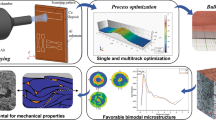Abstract
Using high-power CO2 and Nd:YAG lasers of high beam quality, high process efficiencies and excellent seam qualities are achieved. A particular method for obtaining almost pore-free weld seams without blowholes is the combining of the beams of two CO2 lasers. Without the need for filler material, crack-free welds can be produced in sheets of hot-crack susceptible, precipitation hardened alloys up to a welding speed of 5–7m min-1 for full penetration and up to 3–4m min-1 for partial penetration. In contrast, AlMg alloys containing more than 2.5wt% Mg and AlSi cast alloys are insensitive to hot-cracking even at high processing speeds. Laser welds possess much better static mechanical properties than gas tungsten arc (GTA) or gas metal arc (GMA) butt welds. For the alloys AlMgSi1 and AlMg5Mn the maximum static strength which can be achieved in laser welding is determined by the alloy type, i.e. the hardening mechanism and the heat-treated condition. Laser butt welded car body sheets without filler material exhibit the same load-bearing capacity under dynamical load as GMA welds with filler material. The latest research work has demonstrated that high-quality ‘tailored blanks’ with good mechanical properties can also be made out of different aluminium plates.
Similar content being viewed by others
References
R. Hack, F. Dausinger and H. Hügel, Proceedings of the 13th International Congress on Applications of Lasers & Electro-Optics, ICALEO'94, Orlando, 1994, p. 210.
J. Rapp, C. Glumann, F. Dausinger and H. Hügel, Proceedings of the 26th International Symposium, ISATA'93, Aachen, 1993, p. 95.
C. Glumann, J. Rapp, F. Dausinger and H. Hügel, Proceedings of the 12th International Congress on Applications of Lasers & Electro-Optics, ICALEO'93, Orlando, 1993, p. 672.
Y. Arata, E. Nabegata and N. Iwamoto, Trans. Jpn Weld. Inst. 7 (1978) 233.
M. Nagel, W. Prange and C. Schneider, Ingenieur-Werkstoffe 5(4) (1993) 58.
E. Loechelt, Proceedings of the VDI-Werkstofftag'94, Leichtbaustrukturen und leichte Bauteile, Duisburg, 1994, VDI-Bericht 1080 (VDI-Verlag, Düsseldorf, 1994) p. 461.
Author information
Authors and Affiliations
Rights and permissions
About this article
Cite this article
Rapp, J., Glumann, C., Dausinger, F. et al. Laser welding of aluminium lightweight materials: problems, solutions, readiness for application. Opt Quant Electron 27, 1203–1211 (1995). https://doi.org/10.1007/BF00326476
Received:
Accepted:
Issue Date:
DOI: https://doi.org/10.1007/BF00326476




